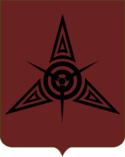Prateek
Prateek (प्रतीक), also Paripateek (पारीप्रतीक), Vanshprateek (वंशप्रतीक) and Rajprateek (राज्यप्रतीक), are Rajyani emblems that are used to identify families, clans, institutions or polities such as the Madhyarajyas (middle kingdoms) and modern-day Union States. There are said to be thousands of Prateeks across Rajyaghar, representing the thousands of families across the nation. The records kept by the Ministry of Clan and Local Affairs only include the prateeks of the registered clans and several hundred notable families across Rajyaghar. Any family or clan may register a Prateek with the Ministry but this is seen as an unnecessary formality by many. Prateeks are comparable to, and often described as the Rajyani equivalent of, Euclean heraldic symbols such as coats of arms.
History
The use of Prateeks originated during the time of the Jhanda Empire during the Dynastic Period of Satrian history. The first known prateek was used by the Empire's founder, Rajaram I, who chose a peacock as the symbol of his ruling family, as it represented wealth, elegance and power. The prateek was then placed on the flag of the empire and quickly became associated throughout Satria with the Jhanda Empire. The use of an easily recognisable symbol to represent the royal family and empire inspired the noble families of the empire to adopt prateeks of their own and their use and influence quickly spread throughout the empire and beyond its expanding borders.
After the fall of the Empire to the Sangma in the Adhenata Kayud, the use of prateeks continued and spread throughout the northern reaches of the Sangma. The newly formed Madhyarajyas within the Sangma would adopt the prateeks of their ruling families as state symbols both during their time in the Sangma and after their secessions. The Naratha Confederacy would continue and promote the use of prateeks throughout the confederacy and with the Southern Conquest, the use of prateeks was now spread to the far corners of the confederacy and what would become modern Rajyaghar.
Colonial Influences
With the arrival of colonial powers in the 19th Century, the differences between prateeks and Euclean heraldry began to diminish. Colonial authorities would routinely redesign prateeks by converting them to charges blazoned in traditional heraldic style rather than traditional rajyani style. Colonial influence also saw the arrival of supporters, mantles and coronets into rajyani heraldry.
The colonial authorities, both Gaullican and Etrurian, would also grant traditional heraldic style coats of arms to loyal colonial citizens and to cities and provinces, further increasing their influence within rajyani culture. During the colonial era, many noble families also adopted the more traditional heraldic style over the traditional rajyani style. The Coat of Arms of Rajyaghar are a notable example of the influence of euclean heraldic style in rajyani heraldry with the royal family adopting an euclean style coat of arms as their family's heraldric symbol.
Types
Today, Rajyani heraldry consists of 2 major branches or types; the prateek style (called Prateeks) and the heraldic style (called Coats of Arms). The prateek style is a single, easily identifiable symbol alone, whereas the heraldic style is a symbol(s), termed a charge, blazoned upon an Etrurian-styled shield. Unlike Euclean heraldry, there is no difference between the shield of a male and female armiger. Prateeks do not have any variations when it comes to heirs, marriages, etc. whereas coats of arms follow the same practices found in euclean heraldry such as cadency, impalement and quartering.
Prateek Style
There are 3 subtypes of Prateek described by the Ministry of Clan and Local Affairs:
- Pariprateek - family emblems
- Vanshprateek - clan emblems
- Rajprateek - state emblems
Rajyani Clans are groups of people united by an actual or perceived kinship and descent which, in most cases, the exact details of this lineage are unknown. In Rajyaghar, clans are organised around a central founding member or ancestor with many families being branches along this lineage. The vanshprateek (clan emblem) is often used by the direct descendants of the founding member, with cadet branches often using their own pariprateeks (family emblems). Families with very distant connections to the original founder (e.g. cadet branches of cadet branches, etc.) will often seperate from the clan and form their own clan or join one to which they have a closer connection to their founder. States which were led by the head of a Clan would use their vanshprateek as the emblem of the state, at which point they would then be called a Rajprateek (State emblem).
Modern Usage
The Princes of the Union States are all heads of their own clans and as such their Vanshprateek is used as the State Emblem of their Union State, making it a Rajprateek. The national seal of Rajyaghar contains the Rajprateek of the Rajana Clan which is the reigning family of the Kingdom as well as the Union State of Sanyukt.
Prateeks are often added to clothes such as saris, bandhgalas and achkans to add formality and for individuals to display their family or clan heritage. On clothing, pariprateeks and vanshprateeks are common whereas rajprateeks are often rare and only used by officials. The Royal Family are known for embroiding their clothes with their vanshprateek.
Whilst records of prateeks are collected by the Ministry of Clan and Local Affairs, prateeks are not regulated by law, with the exception of Rajprateeks and the Vanshprateeks of registered clans, which are protected and their use is regulated.
Prateeks are also utilised by families as logos for their family owned and run businesses and there have been examples of larger corporations using prateeks as their logos. Whilst these logos would not be protected as prateeks, they could, as business logos, be protected under trademark regulations via the Ministry of Trade.
Educational institutions such as universities and schools have often used parateeks associated with their founders or location for their identification. However, since independence, most newly created educational institutions, especially universities, have often opted for modern 'logos' rather than prateeks. Many accredit this to the increasing diversity seen at universities and the aim of their faculty in promoting inclusivity.
Known Prateeks
| Prateek | Status | Type | Notes |
|---|---|---|---|

|
Extant | Rajprateek | National emblem of the Kingdom of Rajyaghar Encorporates the Vanshprakeet of the Royal Family (Rajana Clan) |
| Defunct | Rajprateek
Pariprateek |
Royal emblem of the Jhanda Empire and Dynasty | |
| Defunct | Rajprateek | Confederate emblem of the Naratha Confederacy Triangles represented the three branches of the Naratha River with an interlaced circle representing the unity of the member states | |

|
Extant | Rajprateek
Pariprateek |
State emblem of the Union State of Sanyukt
Family emblem of the Rajana Dynasty (Royal Family of Rajyaghar and ruling family of Sanyukt) |

|
Extant | Vanshprakeet | Clan emblem of the Rajana Clan Variant of the Pariprateek of the Royal Family who are the heads of the Rajana Clan |

|
Extant | Rajprateek
Pariprateek |
State emblem of the Union State of Rathankot
Family emblem of the Mahanta Dynasty (Ruling family of Rathankot) |

|
Extant | Rajprateek | State emblem of the Union State of Sangam |




